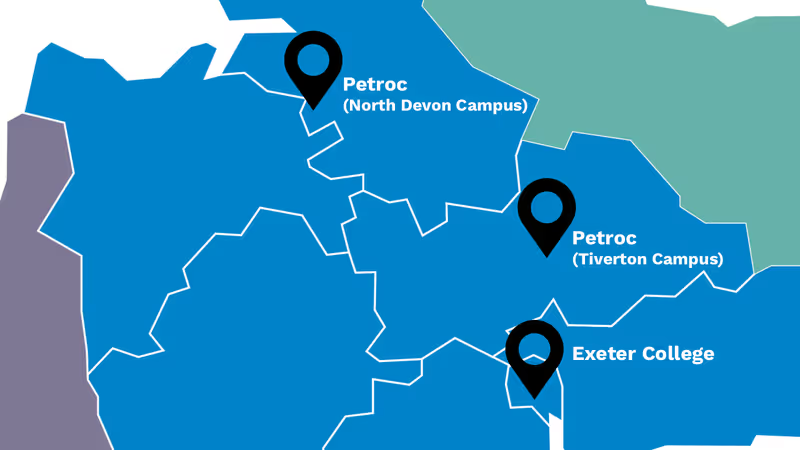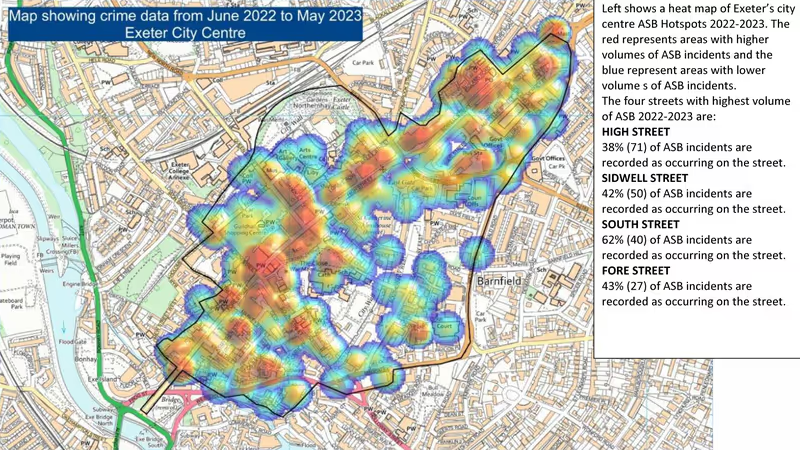Devon’s eleven councils have less than five weeks to develop a joint proposal for local government reorganisation covering the whole of Devon, Plymouth and Torbay after local government minister Jim McMahon invited them to submit their initial plans by 21 March.
In a letter sent earlier this month to all Devon’s council CEOs and leaders, as well as Devon’s thirteen MPs and the Devon & Cornwall Police and Crime Commissioner, the minister also set out the criteria, guidance and timeline for the submission of council reorganisation plans that the government wants delivered in tandem with wider South West peninsula devolution.
His letter followed the December publication of a government white paper that fired the starting gun on the dissolution of England’s remaining 21 two-tier county councils, and the 164 district councils into which they are divided, and their replacement with single-tier unitary local authorities.
Within weeks Devon County Council and Exeter City Council each declared conflicting intentions to go it alone, leaving Devon’s seven other district councils out in the cold, at the same time supporting the creation of a peninsula-wide mayoral strategic authority to sit above the unitaries despite unequivocal opposition to the idea from Cornwall Council and all bar one of Cornwall’s six MPs.
However, the political weather changed when Devon County Council’s plan to postpone the local elections failed alongside its application to join the government’s fast-track devolution priority programme.
A county-wide consensus has since been gaining traction, with most of Devon’s councils already on board, according to several sources who are familiar with the matter. Only Exeter City Council is standing in its way while County Hall has yet to make up its mind.
 Local authority structure in England, December 2024. Source: House of Commons Library.
Local authority structure in England, December 2024. Source: House of Commons Library.
Jim McMahon’s letter repeatedly exhorts Devon’s local authorities to work together to “develop and jointly submit one proposal for unitary local government” for the whole county.
Directly addressing local council leaders, he says: “It is not in council taxpayers’ interest to devote public funds and your valuable time and effort into the development of multiple proposals”, adding that he expects them to make “every effort” to work together “in the best interests of the whole area”.
He also says that while there will be “some cases when it is not possible for all councils in an area to jointly develop and submit a proposal, despite their best efforts” this “will not be a barrier to progress”, echoing the white paper threat that a “ministerial directive” would be used to impose devolution in any areas “where local leaders in that region have not been able to agree”.
While his letter adds that the government will consider “any suitable proposals” submitted by “relevant local authorities”, it sets out criteria for those proposals which make clear that “suitable” leaves little room for manoeuvre for councils like Exeter which want to be an exception to the rule.
The criteria include a requirement that unitary authorities should cover “sensible economic areas, with an appropriate tax base which does not create an undue advantage or disadvantage for one part of the area” and which “avoid unnecessary fragmentation” of public service delivery.
They also say new unitaries should “aim for a population of 500,000 or more”, although they add that there may be “certain scenarios” in which this threshold “does not make sense for an area”, in which cases a rationale for a lower threshold must be supplied.
They add that while existing district council boundaries should provide the “building blocks” for proposals, the government will consider “more complex boundary changes” where there is a “strong justification” for doing so that is related to financial sustainability and public service delivery.
 Jim McMahon local government reorganisation proposals invitation letter. Source: MHCLG.
Jim McMahon local government reorganisation proposals invitation letter. Source: MHCLG.
The government says that councils must also submit “robust evidence and analysis” that identifies the outcomes they expect their reorganisation proposals to achieve alongside projected financial and service delivery benefits across the whole area.
The required evidence and analysis must be derived by councils both working with each other and engaging with residents, businesses, employees and trade unions, local MPs and a range of other stakeholders including NHS integrated care boards, police and crime commissioners, fire and rescue authorities, colleges and universities, national park authorities and the voluntary and third sector.
Evidence of this engagement and an account of the responses that have been gathered as well as explanation of the ways in which local needs and concerns will be addressed must all be provided.
Proposals for new unitary structures must also enable “stronger community engagement” and “genuine opportunity for neighbourhood empowerment”, in an apparent nod to the expectation that some public service functions that are currently performed by district councils will be passed on to the town and parish councils that sit beneath them.
In Exeter, Plymouth and Torbay this will mean that a new lower layer of local government will have to be created to sit alongside Devon’s existing civil parishes.
At the other end of the scale, council reorganisation proposals must also “support devolution arrangements”, with delivery timelines for each that work in tandem.
 Proposed local government structure in England following reorganisation and devolution. Source: MHCLG.
Proposed local government structure in England following reorganisation and devolution. Source: MHCLG.
Fulfilling all these local government reorganisation proposal criteria would be a daunting task for any two-tier area, even with all its local authorities on the same page. It makes Exeter City Council’s determination to go it alone, restated by council leader Phil Bialyk and CEO Bindu Arjoon after the criteria were published, look reckless.
The minister’s unambiguous preference for joint proposals that cover the whole area from all the councils within it suggests that a solo city council bid for unitary status must either explain how it alone envisages unitary local government reorganisation might work across all of Devon, Plymouth and Torbay, in the face of other council preferences, or provide a compelling reason why it does not.
Then there are the requirements to provide evidence and analysis setting out the financial and service delivery consequences of adopting its proposed new unitary structures across the whole area – not only in and around Exeter – while reaching far beyond the city walls to consult with all the stakeholders listed by the government.
The “very substantial effort in data collection, research, analysis and case preparation” that the city council has already admitted would be entailed in submitting its solo bid, with a corresponding “impact on existing work and priorities”, looks like less than half the task.
Going its own way would also put Exeter at odds with an emerging county-wide consensus that is already supported by most of Devon’s councils, frustrating the government’s insistence that “competing proposals” should not be submitted on 21 March.
It would fly in the face of the government’s proposal criteria on just about every other count too.
 Existing Devon unitary and district council boundaries. Source: Ordnance Survey.
Existing Devon unitary and district council boundaries. Source: Ordnance Survey.
The emerging consensus gives Plymouth City Council what it wants: just enough expansion eastwards into South Hams to increase its 269,000 residents to the minimum 300,000 population threshold that the government has cited in response to requests for clarity on this number.
As it is already a unitary authority which delivers all the services that Exeter City Council would have to learn from scratch, Plymouth has a strong case to retain its status this way.
The emerging consensus also enables Torbay Council, already a unitary but among the smallest such councils in the country with 139,000 residents, to form part of a new unitary authority encompassing the rest of South Hams with Teignbridge and West Devon too.
The resulting council would cover a population of about 400,000 and would include all of Dartmoor National Park, currently divided between the three districts. South Hams and West Devon already share officers and jointly deliver some services, and were working towards greater consolidation long before the government first announced its plans for sweeping reform.
The emerging consensus also combines Torridge, North Devon, Mid Devon and East Devon with Exeter to form a third new unitary. With 550,000 residents it would be the most populous of the three, but would largely map on to the economic geography that is Exeter’s travel to work area. Crucially, it would not leave Torridge and North Devon behind.
This arrangement yields a combination of tax-raising potential and consolidated public service delivery capacity across each of the resulting three unitary authorities without creating unjustified advantage or disadvantage in any part of the county. Exactly as the government wants.
It also only slightly departs from existing council boundaries, to the extent that Plymouth expands into South Hams.
In contrast, if comments made by city councillors during discussion of its bid are anything to go by, Exeter’s ambitions only extend about as far as annexing the adjacent Exmouth & Exeter East parliamentary constituency, where Labour came a close second in last year’s general election and it hopes to hoover up business rates and council tax in East Devon’s enterprise zones, Cranbrook, Exmouth and the new town planned near Exeter Airport.
Combining the two constituencies would barely encompass a population of 200,000 – leaving Exeter to explain why it should fall so far short of the government’s unitary population threshold and why East Devon should be cut in half leaving everything east of Ottery stranded.
 Existing Devon parliamentary and district council boundaries. Source: Ordnance Survey.
Existing Devon parliamentary and district council boundaries. Source: Ordnance Survey.
Party politics come into play at County Hall too: its Conservative leadership is yet to decide whether to accept the emerging consensus despite the urgent need for agreement across the board. As a result, the county council elections on 1 May may play an important role.
As things stand, the Liberal Democrats hold more Devon local council seats than any other party, leading five of eight Devon district councils – in partnership with Independents in some cases – and more seats in parliament too. But they hold only ten seats at County Hall while the Conservatives currently have 39.
However Conservative support has fallen 23 points nationwide since these county councillors were elected nearly four years ago, and County Hall’s long-term delivery failures, not least in SEND children’s services, have hammered its reputation as much as its balance sheet. Its 2024-25 SEND overspend rose to £51.6 million last month, £20.4 million more than agreed with the government, meaning its SEND spending deficit is now expected to reach £227 million next year.
Were the Liberal Democrats to do well in the May county council elections, as many expect, they would acquire greater influence at County Hall just as the work of local government reorganisation was gaining pace, perhaps brandishing a cross-county mandate at three electoral levels at once.
Meanwhile, the county council has called another extraordinary meeting for 20 March, one day before the government deadline for the submission of an initial local government reorganisation plan covering the whole of Devon, Plymouth and Torbay.
If it decides to go it alone and submit a bid to form a single Devon-wide unitary authority, as its leader James McInnes said in December, it would also be competing with the emerging consensus and Exeter’s reckless exceptionalist bid. Let’s hope, for the sake of Devon’s reputation in Whitehall as much as the county’s residents and businesses, that it decides otherwise before it meets next month.
Devon is currently on course to submit at least two competing initial local government reorganisation proposals on 21 March. Whitehall will then provide “feedback” to support the development of final area-wide proposals that will be due on 28 November.
The government allows that this submission might include “more than one potential proposal” but only “if there is more than one option under consideration” for the whole area, repeating its expectation that “one interim plan is jointly submitted” by all Devon’s councils.
It says that the “level of detail that is possible at this stage may vary from place to place” but nevertheless sets out eight elements that interim proposals should address.
These include the “size and boundaries” of new unitary authorities, “early views” as to number of councillors that will be required for each, a “summary of local engagement” undertaken so far with “further plans for wide local engagement” to enable subsequent proposal development, and “indicative costs of preparing proposals and standing up an implementation team”.
They also include “early views” on how the proposed new unitaries will support strategic authority development above them and “any barriers or challenges” that might derail the whole process.
It has little to say on subsequent timescales beyond what was included in December’s white paper, other than that new “shadow” unitary council elections should be held “as soon as possible”.
Local government reorganisation timetable
| Date | Other areas |
|---|---|
| 21 Mar 2025 | New unitary authority interim proposals |
| 28 Nov 2025 | New unitary authority full proposals |
| Dec 2025/Jan 2026? | Public consultations on unitary proposals? |
| May 2026 | Phase 1: New unitary authority “shadow” elections |
| Phase 1: New “shadow” unitary authorities prepare budgets etc | |
| Apr 2027 | Phase 1: New unitary authorities take over, old councils abolished |
| May 2027 | Phase 2: New unitary authority “shadow” elections |
| Phase 2: New "shadow" unitary authorities prepare budgets etc | |
| Apr 2028 | Phase 2: New unitary authorities take over, old councils abolished |
Jim McMahon’s letter also has little to say about money. It says “some funds” will be provided to help councils prepare reorganisation proposals, about which there will be “further information later in the process”. Then in just a few words he drops several far-reaching financial bombshells.
First, he says that councils “will be able to meet transition costs over time from existing budgets”. While estimates of local government reorganisation costs vary widely, a Mid Devon District Council report published last week put the Devon bill at £30-£50 million.
Then he says that councils should make “flexible use of capital receipts” to cover these costs and to pay for “future service transformation opportunities from existing budgets”. These euphemisms mean that councils will have to sell assets to make ends meet both during reorganisation and afterwards. A fire sale of publicly-owned land and property looks inevitable unless this changes.
Last, and most ominously, he says: “There is no proposal for council debt to be addressed centrally or written off as part of reorganisation”. Devon County Council’s £227 million cumulative SEND deficit is likely to be the tip of the iceberg: there is a good chance that Devon local government reorganisation will lead directly to one or more of its new unitary authorities sinking under redistributed debt.
When Somerset Council was created in 2023 to replace the county council and four district councils it was expected to save £18.5 million a year. But it declared a “financial emergency” six months later, projecting a deficit of £100 million, and is about to increase its council tax bills by 7.5% in one go.
Meanwhile the Devon & Torbay Combined County Authority has come into being, after being signed into legislation by Jim McMahon on the same day he wrote to two-tier areas to invite their reorganisation proposals. It is expected to hold its inaugural public meeting on 19 March in Tavistock.
While the government does not expect initial local council reorganisation proposals to explain in detail how they will complement the new strategic authorities that will be created in tandem during its wider devolution reforms, Devon’s councils are expected to explain on 21 March how the new combined authority can continue for the time being under the new system.
This will almost certainly mean Plymouth City Council becoming a constituent member, so the new combined authority covers the whole area when the English Devolution Bill becomes law and it becomes a non-mayoral foundation strategic authority next year.
At the same time, while the government has more or less ruled out establishing mayoral strategic authorities that only cover single historic counties like Devon or Cornwall, a loophole is being discussed that might allow Cornwall and the Isles of Scilly to work around this restriction.
The Isles of Scilly Rural District Council was established as a sui generis unitary authority in 1890 before being granted county council “powers, duties and liabilities” in 1930 (and renamed in 1972).
As such, even though it has a population of just 2,300 people, Cornwall and the Isles of Scilly together are technically a pair of adjacent unitary authorities and so appear to meet this government eligibility threshold for mayoral strategic authority status.
Were the government to allow them to form a mayoral strategic authority on this basis, with the Heart of Wessex Combined Authority bid on Devon’s other flank very close to getting government fast-track approval, it would have to consider allowing a mayoral strategic authority in Devon too.










